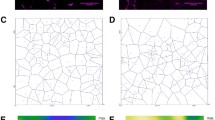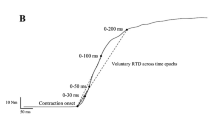Summary
The muscles triceps brachii, quadriceps femoris (part vastus lateralis) and soleus were analysed in 6 men and 6 women for fibre composition (% slow twitch, ST-fibres and % fast twitch, FT-fibres), fibre cross sectional areas, and capillarization. Also the fraction of fibres enclosed by their own fibre type was analysed together with the capillary supply of these fibres. Fibre composition was 39(19–60)% ST in m. triceps brachii, 60(29–78)% ST in m. vastus lateralis and 73(49–88)% ST in m. soleus. Fibre areas ranged from 2,320 to 16,667 μm2 being smallest in m. triceps brachii and largest in m. soleus (p<0.05) and with ST fibres being significantly smaller than FT fibres in some of the muscles. In all muscles the shape of the fibres was elliptical with the larger diameter being about twice the smaller diameter. Capillary density per cross sectional muscle area was not related to the fibre composition and was 379(302–500) cap/mm2 in m. triceps brachii, 404(284–529) cap/mm2 in m. vastus lateralis and 417(333–592) cap/mm2 in m. soleus. However, capillary supply expressed as fibre type area per capillary was up to 40% larger for FT-fibres than for ST-fibres within the same muscle (p<0.05). The capillary supply of enclosed fibres was not different from that of fibres surrounded also by the other fibre type. The results demonstrate that the difference in capillary supply to ST and FT-fibres is less distinct in humans than in other mammals, which is consistent with the metabolic potentials also being more alike.
Similar content being viewed by others
References
Andersen P (1975) Capillary density in skeletal muscle of man. Acta Physiol Scand 95:203–205
Andersen P, Henriksson J (1977) Capillary supply of the quadriceps femoris muscle of man: Adaptive response to exerice. J Physiol 270:677–690
Andersen P, Kroese AJ (1978) Capillary supply in soleus and gastrocnemius muscles in man. Pflüger Arch 375:245–249
Aquin L, Lechner AJ, Sillau AH, Banchero N (1980) Analysis of the shape changes of muscle fibre cross sections in guinea pigs raised at 22°C and 5°C. Pflügers Arch 385:223–228
Bergström J (1962) Muscle electrolytes in man. Scand J clin Lab Invest 14:(suppl 68)1–110
Brooke MH, Kaiser KK (1969) Some comments on the histochemical characterization of muscle adenosine triphosphatase. J Histochem Cytochem 17:431–432
Brown MD, Cotter MA, Hudlicka O, Vrbová G (1976) The effects of different patterns of muscle activity on capillary density, mechanical properties and structure of slow and fast rabbit muscles. Pflügers Arch 361:241–250
Edström L, Nyström B (1969) Histochemical types and sizes of fibres in normal human muscles. Acta Neurol Scand 45:257–269
Edström L, Ekblom B (1972) Differences in size of red and white muscle fibres in vastus lateralis of m. quadriceps femoris or normal individuals and athletes. Scand J Clin Lab Invest 30:175–181
Essén B, Jansson E, Henriksson J, Taylor AW, Saltin B (1975) Metabolic characteristics of fibre types in human skeletal muscle. Acta Physiol Scand 95:153–165
Essén B (1980) Metabolic characteristics of human type 2 skeletal muscle fibres. Muscle & Nerve. May/June, p 263
Gollnick PD, Sjödin B, Karlsson J, Jansson E, Saltin B (1974) Human soleus muscle: A comparison of fiber composition and enzyme activities with other leg muscles. Pflügers Arch 348:247–255
Gray SD, Renkin EM (1978) Microvascular supply in relation to fibre metabolic type in mixed skeletal muscles of rabbits. Microvasc Res 16:406–425
Grunewald W (1973) The influence of the three dimensional capillary pattern on the intercapillary oxygen diffusion — a new composed model for comparison of calculated and measured oxygen distribution. In: Kessler M et al (eds) Oxygen supply. Urban & Schwarzenberg, München Berlin Wien, pp 5–17
Ingjer F (1979) Capillary supply and mitochondrial content of different skeletal muscle fibre types in untrained and endurance-trained men. A histochemical and ultrastructural study. Eur J Appl Physiol 40:197–210
Ingjer F, Brodal P (1978) Capillary supply of skeletal muscle fibres in untrained and endurancetrained women. Eur J Appl Physiol 38:291–299
Jansson E, Kaijser L (1977) Muscle adaptation to extreme endurance training in man. Acta Physiol Scand 100:315–324
Johnson MA, Polgar J, Weightman D, Appleton D (1973) Data on the distribution of fibre types in thirty-six human muscles. An autopsy study. J Neurol Sci 18:111–129
Padykula HA, Herman E (1955) The specificity of the histochemical method for adenosine triphosphatase. J Histochem Cytochem 3:170–195
Peter JB, Barnard RJ, Edgerton VR, Gillespie CA, Stempel KE (1972) Metabolic profiles of three fibre types of skeletal muscle in guinea pigs and rabbits. Biochemistry 11:2627–2633
Polgar J, Johnson MA, Weightman D, Appleton D (1973) Data on fibre size in thirty-six human muscles. An autopsy study. J Neurol Sci 19:307–318
Romanul FCA (1965) Capillary supply and metabolism of muscle fibres. Arch Neurol 12:497–509
Salathé EP (1982) Mathematical modeling of oxygen transport in skeletal muscle. Math Biosci 58:171–184
Saltin B, Henriksson J, Nygaard E, Jansson E, Anderson P (1977) Fiber types and metabolic potentials of skeletal muscles in sedentary man and endurance runners. Ann NY Acad Sci 301:3–29
Sillau AH, Banchero N (1977) Effect of maturation on capillary density, fibre size and composition in rat skeletal muscle. Proc Soc Exp Biol Med 154:461–466
Sillau AH, Banchero N (1978) Skeletal muscle fibre size and capillarity. Proc Soc. Exp Biol Med 158:228–291
Sjøgaard G, Houston ME, Nygaard E, Saltin B (1978) Sub-grouping of fast twitch fibres in skeletal muscles of man. A critical appraisal. Histochemistry 58:79–87
Author information
Authors and Affiliations
Rights and permissions
About this article
Cite this article
Sjøgaard, G. Capillary supply and cross-sectional area of slow and fast twitch muscle fibres in man. Histochemistry 76, 547–555 (1982). https://doi.org/10.1007/BF00489909
Accepted:
Issue Date:
DOI: https://doi.org/10.1007/BF00489909




